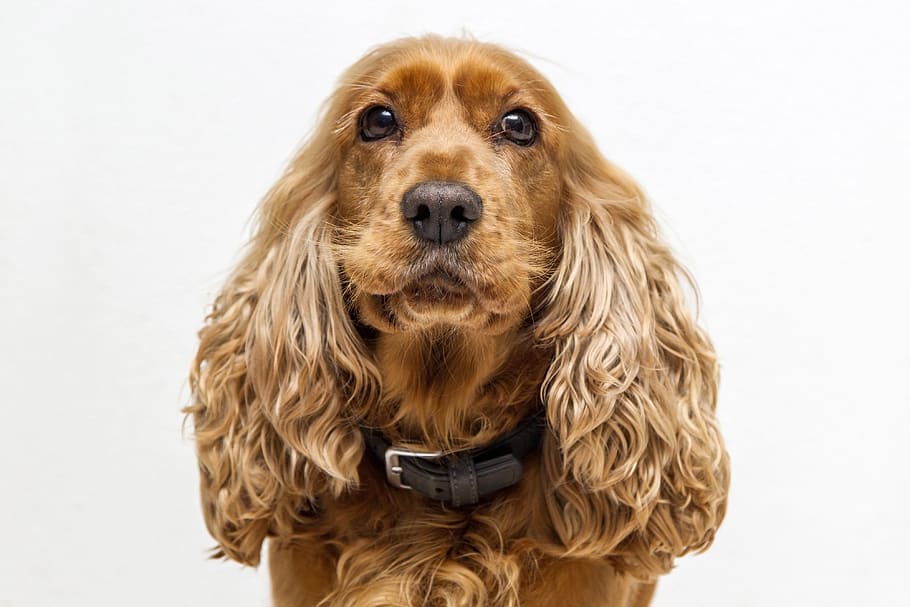Do you want to have a Cocker Spaniel as a new pet?
Because of their active and friendly demeanor, these adorable pups are popular among families, but they aren’t right for everyone.
With his large, dewy eyes and mischievous disposition, the Cocker Spaniel is one of the most popular dog breeds in the United States.
They were once used as hunting dogs, but they have since earned a large following as much-loved family pets.
This dog breed are medium-sized dogs that stand around 15 inches tall, making them suitable for any home.
Cocker Spaniel are easy to teach and make wonderful playmates for children.
The Cocker Spaniel is a sporting breed that was developed to work and enjoys nothing more than spending time on the trail with his owners.
We cover everything you need to know about the Cocker Spaniel breed in this helpful post.
You’ll learn about the origins of the Cocker Spaniel, what to expect from the breed as a companion, and the potential health challenges that the breed may face.
So, let’s learn everything there is to know about the adorable Cocker Spaniel!

Related Articles:
Where Did Cocker Spaniels Originate From? [Answered]
Best Brush for Springer Spaniel: A Look at the Top Choices
Table of Contents
What is the appearance of a real cocker spaniel?
The well-groomed Cocker Spaniel is one of the most attractive breeds.
Short on the head and back, but long on the ears, chest, belly, and legs, his thick, occasionally wavy coat is short on the head and back and long on the ears, chest, belly, and legs.
A solid color coat (black or light cream to red to brown) or a parti-color coat (black or light cream to red to brown) is available (two or more colors, one of which is white).
History
The roots of the Cocker Spaniel are supposed to date back to the 14th century’s “Spanyells.”
Over the years, the Spaniel breed expanded and evolved into a variety of various forms, each with its own set of skills.
On command, certain Spaniels were used to flush game and retrieve shot birds.
The term “Cocker” is derived from the dog’s ability to hunt woodcock.
Spaniels were formerly categorized and grouped based on their size.
As a result, multiple varieties of Spaniels may be born in the same litter.
Eventually, the numerous Spaniel breeds were recognized as distinct breeds.
The Cocker Spaniel was recognized as a distinct breed in 1946.
The popularity of the breed skyrocketed thanks to the 1955 Disney film Lady and the Tramp.
According to American Kennel Club records, the Cocker Spaniel was the breed of preference for families in the United States until 1990.
The Cocker Spaniel is now ranked #25 on the list, but his cheery demeanor, adaptable size, and intelligence make him a popular choice for anyone searching for a family companion.
The modern Cocker Spaniel, like the Golden Retriever and Labrador Retriever, is the smallest member of the Sporting Group.
In addition to being a wonderful family companion, the Cocker Spaniel has a working role in field sports.
Cocker Spaniels are also seen competing in dog agility contests.
Temperament
Springer Spaniel are recognized for their happy, calm demeanor.
They are loyal, affectionate, kind, and fun companions.
Cocker Spaniels are popular as family pets because they get along well with children and other animals.
However, even with adequate early socialization, they can be fearful.
Because of this delicate mentality, aggressive training approaches should be avoided.
To avoid your Cocker Spaniel becoming scared, employ persistent and gentle training approaches to achieve the desired objectives.
Dogs communicate by barking, and Cocker Spaniels like attempting to converse with humans.
Teaching kids the instruction “silent” can assist to deter this type of behavior.
Cocker Spaniels have a strong prey drive because they were bred as hunting dogs.
When you’re out and about, it’s better to keep him on a leash.
They are also eager to please their owners because of their hunting drive.
Dimensions and Appearance
Cocker Spaniels are medium-sized dogs that measure between 14 and 15 inches tall at the shoulder and weigh around 30 pounds.
Male Cocker Spaniels are slightly larger than female Cocker Spaniels.
Their muzzles are large and square, and their heads are beautiful and domed.
Their backs slant toward the tail, giving the pup a royal aspect.
Their long, feathery ears that flap on either side of their heads are one of their most distinguishing traits.
People can’t get enough of these luscious ears!
Because of their wide, dreamy, imploring brown eyes, the Cocker Spaniel was most likely the inspiration for the expression “puppy dog eyes.”
Whether they’re four months old or fourteen years old, they still have that puppy gleam.
Colors & Coat
Cocker Spaniels have silky coats that can be straight or slightly wavy and range in length from medium to long.
Long, luxuriant feathering adorns the legs, chest, and belly of cockers.
Cockers are available in a variety of gorgeous hues, including:
- Gold
- Red
- Chocolate
- Black
- Tan and Black
- Tan and Liver
- Orange and White
- White and Liver
- White and Lemon
- Black and White
- Black, White, and Tan
- White, Tawny, and Liver
Blue, orange, liver, lemon, blue roan and tan, and liver roan and tan are among the roan colors available.
It’s not unusual for Cocker Spaniels to have spotty coats.
Exercise
Working dogs were bred into Cocker Spaniels.
As a result, they are active and energetic, requiring a lot of activity to stay happy.
You should take your Cocker Spaniel for two daily walks and offer him plenty of playing.
However, most Cockers would rather to spend a rainy afternoon curled up on your lap in front of the fire.
Conditions of Life
Although you could theoretically keep a working Cocker Spaniel outside overnight, there are a few reasons why this isn’t a smart idea.
- If a Cocker is used to staying indoors with his or her human family, he or she will develop separation anxiety, which will result in howling and barking if left outside overnight.
- Cockers will dig if they are restricted away from their owners and get anxious. You can bet that if your “run” is partially on grass, your Cocker Spaniel will dig a hole in it.
- If a cocker becomes anxious after being left alone for an extended period of time, they will gnaw and ruin their nighttime lodging. Cocker Spaniels have been known to chew their own paws till they’re raw when they’re stressed.
Finally, isolating your home-loving Cocker Spaniel may cause him to lose faith in you and your family.
Your pet may become more hostile toward you, as well as less docile and difficult to train.
Training
American Cocker Spaniel are easy to train in general.
However, because the breed is so sensitive, you’ll get a lot more done if you adopt positive training methods.
With lots of praise, treats, and a clicker, you’ll get a lot further than with a choke chain and a strict attitude.
It’s worth noting that the breed has a reputation for urinating when threatened or subservient.
So, if you’re overly harsh or heavy-handed, you can end up with a scared, angry puppy and a wet carpet!
Some Cocker Spaniels have a stubborn streak that can make training difficult.
Strike a balance between giving kind, kind counsel and being tough, persistent, and consistent in your instructions.
When training Cockers, keep in mind that these dogs have a very keen sense of smell.
As a result, a Cocker may be tempted to follow a tantalizing scent, ignoring your instructions to return.
As a result, you should teach your Cocker Spaniel a strong recall command and walk him on a leash whenever possible, allowing him to run off-leash only in a gated, off-leash dog park area.
Health
Cocker Spaniels, like all pedigree breeds, are prone to a number of genetic health issues, including:
- Cataracts and glaucoma
- Hip dysplasia
- Luxation of the patella
- Disc degeneration
- Problems with the liver
- Epilepsy
- Coronary artery disease or Heart Disease
Disorders of the Eye
Cocker Spaniels are especially prone to eye problems.
On which it can range from “cherry eye,” which can be treated with surgery, to sight-threatening illnesses like cataracts and glaucoma.
Many Cocker Spaniels lose their vision completely in their senior years, while sight loss in younger dogs can start as early as a few years of age due to gradual renal atrophy.
Cocker Spaniels are also susceptible to keratoconjunctivitis sicca, or dry eye, a condition in which the dog’s eyes do not produce enough tears, resulting in corneal issues.
Hypothyroidism
Hypothyroidism is a condition in which the thyroid hormone is produced insufficiently.
Lethargy, weight gain, skin infections, shivering, and hair loss are all symptoms of this condition.
Hearing and Ear Problem
Congenital deafness affects some white, blue-eyed Cocker Spaniels.
The merle gene is to blame for these issues, which are incurable.
As a result, it’s recommended to avoid purchasing a puppy with these features.
Long Spaniel ears have a tendency to retain dirt and moisture in their ear canals.
This creates an excellent environment for yeast and bacteria to thrive, resulting in chronic ear infections.
Clean your Cocker Spaniel’s ears on a regular basis to avoid complications.
Poor ear health and frequent infections can cause irreversible damage, so keep a watch on your Cocker’s ears and seek medical help as soon as possible if you notice anything wrong.
Diseases of the Autoimmune System
Autoimmune disorders, such as autoimmune hemolytic anemia, can affect Cocker Spaniels (AIHA).
The immune system targets the dog’s red blood cells in AIHA-affected dogs, resulting in severe anemia.
The sickness is treatable, the mortality rate among English Cocker Spaniel is affected by it’s significant.
All of their breeding stock is screened for genetic illness, and only the strongest, healthiest specimens are used in breeding.
Even a well-bred puppy can, on occasion, get one of these disorders.
So, before buying a puppy, always inquire about the ages of the animal’s relatives and what caused their deaths.
A Cocker Spaniel’s average lifespan is between 12 and 15 years.
Final Thoughts
If you’re searching for a medium-sized dog that’s nice with kids and has a loving, friendly demeanor, a Cocker Spaniel could be the perfect family companion for you.
Although the Cocker enjoys relaxing with his human family, he has a lot of energy to expend, so you’ll need to schedule time for him to exercise.
Frequently Asked Questions (FAQ)
Because Cocker Spaniels are high-strung, talkative dogs, they are especially prone to developing a habit of barking at delivery personnel.
Because this habit is self-rewarding, it might be difficult to eliminate.
Cocker Spaniels are energetic canines who enjoy playing.
Because their tails are always wagging, they’re known as ‘happy’ dogs.
Cocker Spaniels have become popular family pets despite their origins as gun dogs.
Cockers are people-oriented dogs who like having companionship throughout the day.
Cocker Spaniels are quite adaptable and may be kept both indoors and outdoors. Cocker Spaniels can also swim well.
Their lengthy hair needs to be brushed on a regular basis, and they do shed a little.


![Breeding Cocker Spaniels [Facts] Breeding Cocker Spaniels [Facts]](https://spanielking.com/wp-content/uploads/2021/11/Cockers-150x150.jpg)
